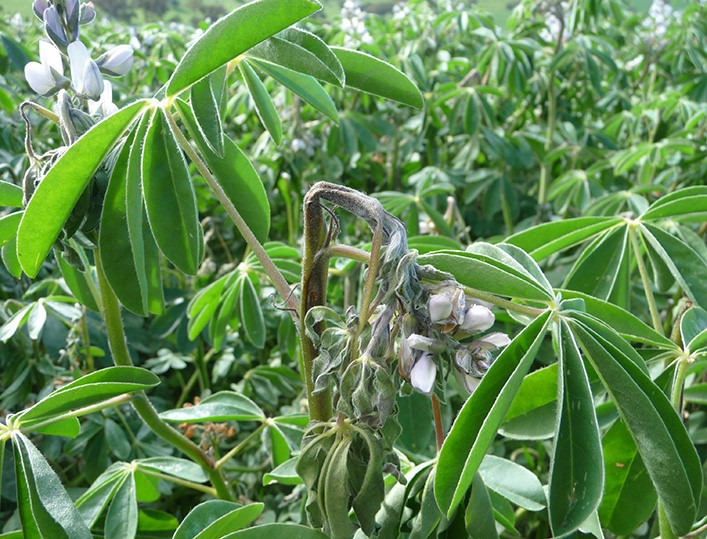Lupin Anthracnose update: September 2020
In October 2016 lupin anthracnose was detected for the first time in commercial crops in NSW in the eastern Riverina region. NSW DPI and LLS rapidly implemented a response plan to eradicate the disease. With cooperation from affected growers a case-by-case assessment of the infected crops was implemented to contain and control the disease. A lupin anthracnose biosecurity management zone was established, restricting the planting of lupins within the zone during the eradication response.
Update
Ongoing surveillance of lupin crops for the disease within the zone and across NSW has found no re-occurrence of disease but 2020 seasonal conditions are similar to 2016 in many areas of NSW and there are many lupin crops that are reaching the stage now where symptoms may become obvious.
Growers and advisors are asked to monitor crops closely in the next 2-4 weeks and report anything suspicious.
The disease
 Lupin anthracnose is caused by the fungus Colletotrichum lupini, previously known as Colletotrichum gloeosporioides.
Lupin anthracnose is caused by the fungus Colletotrichum lupini, previously known as Colletotrichum gloeosporioides.
Lupin anthracnose is a serious disease of lupins. The disease has potential to cause complete crop losses in susceptible varieties.
Notifiable status
Lupin anthracnose (Colletotrichum lupini) is a notifiable plant disease in NSW.
All notifiable plant pests and diseases must be reported within 1 working day. You can report notifiable plant pests and diseases by one of the following methods:
- Call the Exotic Plant Pest Hotline 1800 084 881
- Email biosecurity@dpi.nsw.gov.au with a clear photo and your contact details
- Complete an online form
A full list of notifiable plant pests and diseases can be found in Schedule 2 of the NSW Biosecurity Act 2015.
Symptoms
Symptoms of lupin anthracnose can be seen on all above ground parts of the host plant. If infection occurs early in the season lesions can be found on seedlings.
The most obvious symptom in lupins is bending and twisting of stems, known as the “shepherds crook”, which is particularly noticeable when the crop is flowering (Figure 1).
Oval shaped lesions occur on the stem and eventually lead to collapse and bending of stems. Lesions can be up to 2 cm in length and contain a bright orange/pink spore mass.
Main stems and lateral branches can be affected, with similar symptoms also found on leaf petioles.
Later in the season as the disease progresses, lesions can develop on the pods, distorting and twisting them. Infection of pods can lead to complete pod loss, and the production of infected seed. Infected seeds can be malformed, and have brown lesions on the surface. Seeds can also be infected without showing visible symptoms.
Disease lifecycle
Initial infection occurs from the fungus carried on or within infected seed. Seedlings emerging from infected seed may develop lesions.
Lesions produce an abundance of fungal spores which are spread through the crop by rain splash. The fungus can survive over summer on infected stubble and spores can be splashed to re-infect seedling lupins planted into infected stubble. Rain decreases the viability of the fungus on stubble making it less likely to survive through the following winter and spring conditions.
Spread
Infected seeds are the main source of spread of lupin anthracnose. The fungus can survive for up to two years on lupin seed and possibly longer under some conditions.
Lupin anthracnose can also be spread by infected stubble through rain splash, and movement of spores by contaminated machinery, vehicles, people, animals and fodder between lupin crops and cropping areas.
Hosts
All lupin species are affected, but generally albus lupin (Lupinus albus) and yellow lupin (L. luteus) are more susceptible than narrow leafed lupin (L. angustifolius).
Lupin anthracnose does not affect other broadacre crops.
World distribution
Lupin anthracnose occurs in all lupin growing countries of the world. It is the most damaging disease of lupins in Europe, North America, South America and New Zealand.
Australian distribution
Lupin anthracnose is established in Western Australia and has spread through wild populations of blue lupins (L. cosentinii). Lupin anthracnose has also been found in commercial lupin crops on the Eyre Peninsula and south east cropping regions of South Australia.
Market access and legislation
Regulations apply for the movement of lupin plant material, used packaging and used agricultural equipment into NSW. Details for this legislation are in the Biosecurity Regulation 2017 and the Biosecurity Order (Permitted Activities) 2017.
Actions to minimise risks
Put in place biosecurity best practice actions to prevent entry, establishment and spread of pests and diseases:
- practice “Come clean, go clean”
- ensure all staff and visitors are instructed in and adhere to your farm hygiene requirements
- monitor your crop regularly
- investigate sick plants
- keep records
- abide by legislation